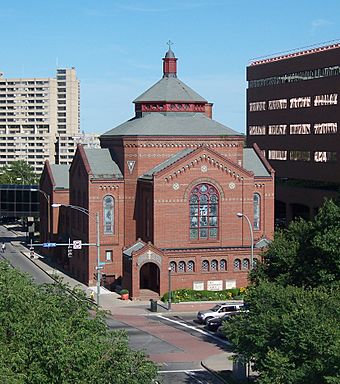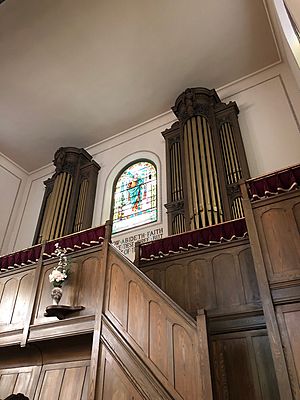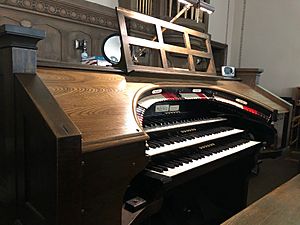First Universalist Church (Rochester, New York) facts for kids
Quick facts for kids |
|
|
First Universalist Church
|
|

First Universalist Church, August 2008
|
|
| Location | SE corner of S. Clinton Ave. and Court St., Rochester, New York |
|---|---|
| Area | less than one acre |
| Built | 1907-1908 |
| Architect | Bragdon, Claude Fayette |
| MPS | Inner Loop MRA |
| NRHP reference No. | 71000545 |
| Added to NRHP | May 27, 1971 |
The First Universalist Church is an old and important church building in Rochester, New York. It's located at 150 S. Clinton Ave. This church belongs to the Unitarian Universalist Association. Building started in September 1907 and finished in October 1908. It is one of two Unitarian Universalist churches in Monroe County, New York. The other is the First Unitarian Church of Rochester.
Contents
What the Church Believes and Does
The First Universalist Church holds a worship service every Sunday. From March 2020 to November 2021, services were held online because of the COVID-19 pandemic. Since November 2021, they have offered "hybrid" services. This means people can join online using Zoom or attend in person at the church building.
This church welcomes everyone. Its website says they have "no shared creed." Instead, they follow "Seven Principles" that support "the free and responsible search for truth and meaning." While Unitarianism and Universalism started as Christian traditions, some members also follow other faiths. Others hold humanist beliefs or are atheists.
The church's main goal is "to nurture the spirit, and serve the community."
How the Church Serves its Community
The First Universalist Church helps its members and the wider community through many active groups. These groups include:
- The Board of Trustees
- Caring Committee
- Communications Committee
- Finance Committee
- House Committee
- [Lifespan Faith Development]
- Membership Committee
- [Committee on Ministry]
- [Music Committee]
- Nominating Committee
- Personnel Committee
- Faith In Action Council (FIAC)
- [Social Justice Project Teams] (also called "Social Justice Circles")
- Worship Committee
- COVID Task Force
The First Universalist Church is known as a [Welcoming Congregation]. This means they are officially recognized by the Unitarian Universalist Association for being open and accepting of all people, including those who are LGBTQ+.
The church shares news and updates in a few ways. They send out a small digital [weekly email] about church events. They also publish a [monthly newsletter] called "Our Outlook." This newsletter is available on their website and is also mailed out. You can find [archives] of these publications, along with past sermons and [annual reports], on their website.
Supporting Black Lives Matter
In the summer of 2020, members of the First Universalist Church supported local Black Lives Matter protests. This happened both before and after the public learned about the death of Daniel Prude involving the Rochester Police Department.
At first, the church set up a table with supplies for protestors. They also made their restrooms available. As the protests continued into the fall of 2020, the church began to host the [Rochester Street Medic Collective].
The medics used the church's Clara Barton lounge area, which is near the parking lot. This spot became a base for storing their supplies. It was also used as a temporary place to give medical help. Church members continued to give water, food, and other supplies to protestors and medics during this time.
Church Building Design
The church building was designed by a famous Rochester architect named Claude Fayette Bragdon. It is built in the Romanesque Revival style. This style often uses round arches and strong, heavy walls.
The church is made of brick with stone and ceramic tile decorations. It has a tall central tower with a pointed roof. Experts from the Library of Congress have described the building's design as "Unified in concept, harmonious in proportions and color." This means the building's parts work well together, and its colors are pleasing. They also noted that most of the building looks just as it did when it was first built.
The First Universalist Church was added to the National Register of Historic Places on May 27, 1971. This means it is recognized as an important historical site.
Little Free Library
The First Universalist Church has a Little Free Library. This is a small box where people can take books, clothes, and other items for free. Anyone can look through the items or take what they need.
In the summer of 2019, the roof of the Little Free Library was damaged. It was repaired and rebuilt. By September 2019, it was shingled and put back in place.
The Hope-Jones Organ
The First Universalist Church of Rochester is home to a very special organ. It is a Hope-Jones organ that has been fully preserved. This means it is still in its original condition.
People have described the sound of this organ as "weighty and lush." It has large 8-foot stops, which help create its rich sound. Not many Hope-Jones organs still exist today, making this one quite rare and important.
Images for kids
-
The indoor Black Lives Matter Banner at First Universalist Church of Rochester, hung in March 2019.
-
Hanging of the outdoor Black Lives Matter banner on 9/1/19.
















